
T W E N T Y F I R S T E D I T I O N
T H E B U I L D I N G C O N S E R VAT I O N D I R E C T O R Y 2 0 1 4
1 6 3
INTERIORS
5
PATTERNS OF USE
In the early 18th century it was not
uncommon for wainscoting, including
the skirting, to be grained. At this time it
was normal practice to imitate only one
timber within a room and the more complex
juxtaposition of different timbers was rare.
This rule was also normally true within a
suite of rooms relating to one another, where
each of this series of rooms was grained in
imitation of the same timber.
In broad terms, through the Palladian
period much of the joinery framework within
a room was painted white, including the
dado and the window and door architraves.
As a consequence, imitation graining was
restricted to the doors and sometimes the
windows also. Later in the century, the
neo-classical style introduced colour to the
timber framework, and the use of graining
was restricted once more to doors and
occasionally windows, if used at all.
The approach was to change in the
Regency period when the use of graining
became more prominent in interiors. No
longer restricted to the door face, it was
applied to any of the timber surfaces within
a room such as dados, windows, shutters,
architraves and, of course, doors. Although in
some more elaborate interiors such as those
found at the Brighton Pavilion created for the
Prince Regent at the beginning of the 19th
century, examples could also be found on the
timber ceiling. More and more exotic timbers
were imitated and less thought was given to
restricting a room to one type of timber only.
The result was that these various finishes vied
for the attention of the visitor’s eye.
Despite objections to the art of
imitation from some quarters, in general
the fashion for graining grew in the
Victorian period. Examples of its use
could now be found on all timber surfaces
within a room. Furthermore, as its appeal
broadened it could be found in more humble
abodes, and by the 1830s graining was
being championed for use in cottages.
TECHNIQUES
It is clear from an examination of builder’s
manuals that there is a change in the
grainer’s objective over time. While in the
early 18th century the painter sought to give
an impression of graining, stylistically it
remained a decorative and fanciful feature.
However, in the 19th century there was an
ever increasing tendency to take nature as
a model in order to recreate an accurate
copy of the wood in question. Inherent in
this change of objective was a shift in the
techniques employed. In the early 18th
century manuals indicate that the graining
pattern was built up principally through the
application of shading in opaque colours,
while translucent glazes were favoured in
the Regency and later periods to evoke the
appearance of the decorative timber. Despite
this trend, there is evidence to suggest that
these two approaches existed side by side,
with the former representing a cruder more
primitive form of graining than the latter.
Although mention is made in decorator’s
Octagon Room, Attingham Park, after completion of graining
Octagon Room, Attingham Park: close-up of
completed graining
Cross-section of the Octagon Room's Regency
graining scheme


